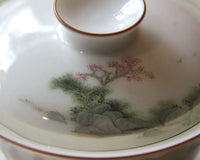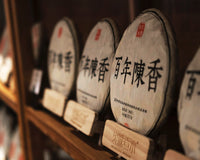Both Sheng Puerh Tea (生普洱茶) and Shu Puerh Tea (熟普洱茶) originate from Yunnan, but they are distinctly different in appearance and taste. This is due to the unique processing techniques for each.
In this article we hope to shed light on the production process for Shu Puerh tea. We hope you will also read our article on Sheng Puerh Production so that you can compare them.
Shu Puerh Origins
The origin of Shu (aka "Ripe") Puerh is refreshingly transparent, unlike many aspects of Chinese tea culture; it traces back to a decision by the Kunming tea factory in 1973 to replicate the natural ageing of Sheng Puerh (what we now call "Raw" Puerh). Without this invention of an 'artificial ageing process' there would be no need to distinguish Puerh types, and only vintage and origin would be the differentiating factors of Puerh tea.
Shu Puerh production is the artificial ageing process, commonly translated as ‘artificial fermentation’. It was designed as a means to accelerate the natural maturation of Sheng Puerh. Henceforth, Sheng Puerh was referred to as "Raw" Puerh and Shu Puerh became "Ripe Puerh".
Ripe (Shu) Puerh is produced under the control and supervision of factories that specialise in this artificial fermentation process. These factories may be small-scale operations located near tea plantations or larger-scale ones found in county capitals such as Menghai or Puerh City.
The specifics of the process are the preserve of each factory's 'special recipe'; some factories may add micro-organisms to act as catalysing agents to accelerate the ageing process.
Generally speaking, the source tea (Mao Cha 毛茶) used for producing both Raw and Ripe Puerh is approximately the same. Although it should be noted that factories producing Ripe Puerh may select their source tea from a number of tea regions to create a signature blend.
Basic Ripe Puerh Production Method
1. Wet-Piling

Wet Piling
In the first step of Shu Puerh production, large batches of finished Mao Cha 毛茶 arrive at the factory. After undergoing inspection the tea is piled up into heaps and organised into mounds of a manageable height. A breathable canvas is then placed over these tea mounds and a fixed amount of water is sprayed onto the canvas to create the desired level of humidity.
This wet-piling method, called Wo-Dui 渥堆 in Chinese, was invented by the Kunming Tea Factory, under the name of 'Artificial Fermentation'. Whether or not this process is actually fermentation is still a matter of debate.
During wet-piling, the confluence of temperature and humidity is the catalyst for fermentation, and it is adjusted according to the condition of the raw leaf and the prevailing weather conditions. Throughout this process, the fermentation supervisor is in direct control; at precise intervals workers will be instructed to stir the mounds of fermenting leaves.
This stage of production may take several weeks, or even longer, depending on the depth of maturation/fermentation required.
2. Sorting

Sorting the dry Puerh Mao Cha
When the fermentation process is finished the leaves are then sorted in-house. In larger factories machines are used to sort the tea into grades, at which point workers take over and sort manually, crouching on small stools and meticulously picking out undesired leaf and twigs from leaves piled onto large, circular bamboo trays. The resultant leaves are weighted and prepared for compression into the desired shape.
3. Compression

Pressing the Puerh tea into tea cakes
The ripened leaf is weighed and placed into buckets which are perforated at the base. The buckets are placed over a steaming device. The steam passes through the perforations and into the compacted leaves.
This short period of steaming helps soften the leaves and increase their malleability. The softened leaf is lifted from the bucket and placed into linen bags for shaping. These small tea parcels are then either compressed manually or mechanically, and placed individually onto nearby shelves.
4. Final Dehydration
At this point the cakes still retain a certain amount of moisture, so they are removed from their linen wrap and placed into a dehydration room to allow natural evaporation. It is vital that the Puerh cakes are fully dehydrated before being packaged, otherwise any moisture concealed or trapped inside the packaging will adversely affect the quality of the Puerh tea cake.
If you've ever wondered "What is Shu Puerh?" then we hope this article has left you feeling more knowledgeable about it.











